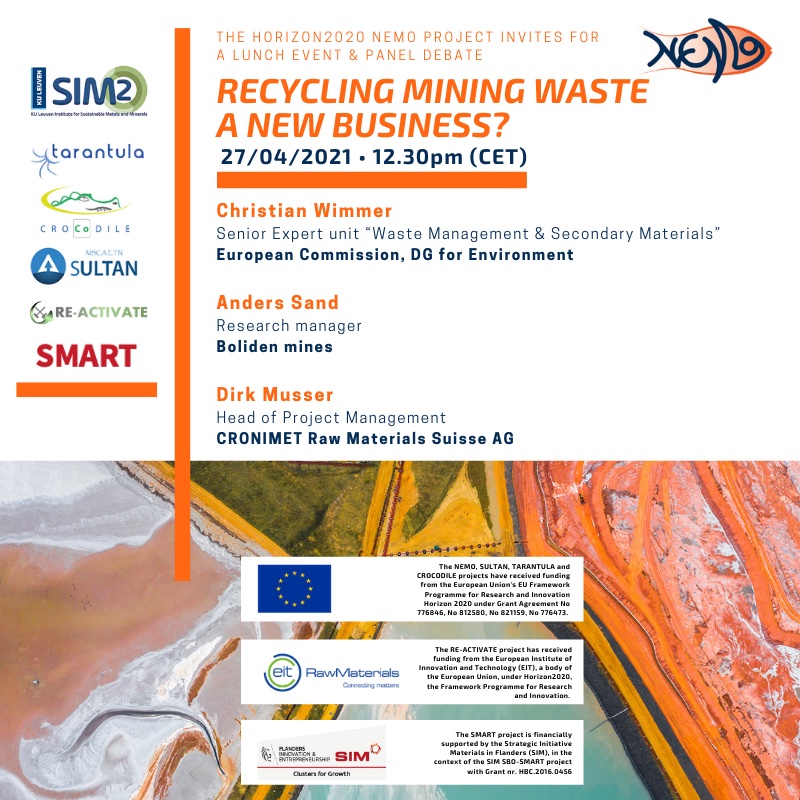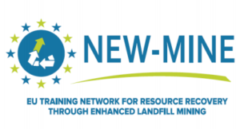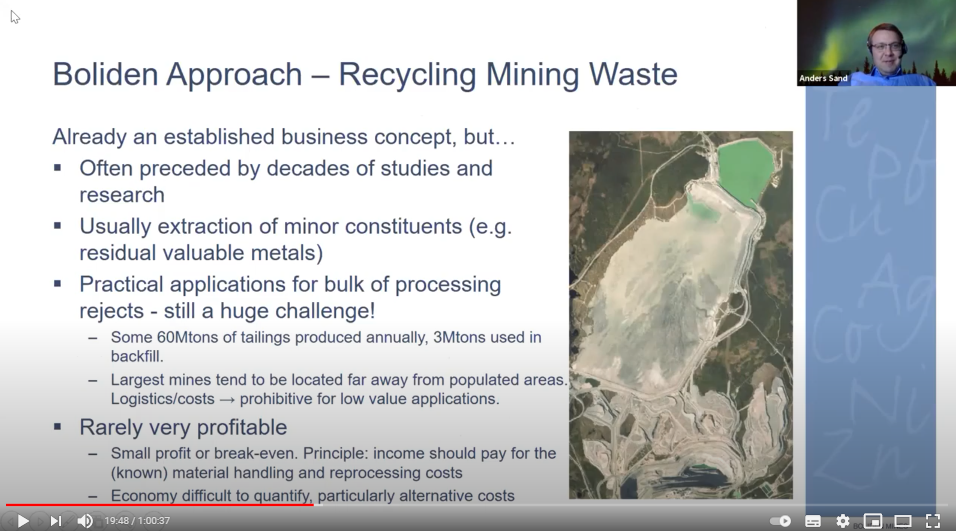On April 27 more than 220 people participated in the on-line event “Can the recycling of mining waste become a new business?” Covering distinct case-studies, three experts – representing EC DG Environment, Boliden & Cronimet – shared their views on the matter of remining extractive waste and went into debate with the audience. In this article Peter Tom Jones (SIM² KU Leuven) (1) summarises five lessons learned.
Executive summary
- Lesson #1. Remining of extractive waste is not a new business
- Lesson #2. Remining of European mining waste has significant potential
- Lesson #3. Remining becomes more treacherous for remote sites
- Lesson #4. A broader adoption of remining extractive waste will require some form of subsidy
- Lesson #5. A broader adoption of remining extractive waste will require a dedicated regulatory framework
“Can the recycling of mining waste become a new business?”, that was the core question addressed in the Lunch Event & Debate organised by the Horizon2020 NEMO project in collaboration with SIM² KU Leuven and several other project teams (SULTAN, TARANTULA, CROCODILE, RE-ACTIVATE, SMART). The event, which was organised as a Zoom-event, attracted more than 220 participants. The goal was to present novel solutions for the treatment of mining waste. Cases from historical and present day mining sites were presented. The target public comprised stakeholders from industry, academia, government and civil society. The full recording of the event can be viewed here.
Mining waste
Since the earliest days of the Industrial Revolution, the primary mining and metal processing industry has been landfilling and/or stockpiling vast quantities of waste. This waste type, termed “extractive waste”, is considered as one of the largest waste streams in Europe. Specific precautions need to be taken when dealing with sulphidic mine tailings (the primary scope of the EU NEMO project), as upon oxidation of residual sulphides, acidic waters are generated. These can result in the release of residual heavy metals to surface and ground waters. Especially in the case of historical mining sites, pre-dating the EU Extractive Waste Directive, this can cause problems, as these sites in general lack the required environmental protection.
Lessons learned from the event (full recording available here)
During the first part of the event the three invited speakers presented their views. Christian Wimmer (EC, DG ENV) addressed the opportunities and challenges in the recovery of secondary raw materials from extractive waste based on his experience with the implementation of the Extractive Waste Directive and related Horizon2020 projects (presentation C. Wimmer here). Secondly, Anders Sand (Boliden) presented Boliden’s perspective in terms of reprocessing historic tailings and extracting valuable by-products from waste streams (presentation A. Sand here). Thirdly, Dirk Musser (Cronimet) focussed on a number of specific case-studies his company has been involved in, including the treatment of slag dumps in the US (presentation D. Musser here).
In the second part of the event, the audience got the chance to ask critical questions through the on-line chat form. The debate was moderated by Piet Wostyn (KU Leuven). Based on the lively debate between the speakers and the audience, the following lessons can be drawn.
Lesson #1. Remining of extractive waste is not a new business
Both speakers from industry answered the central event question – i.e. “Can the recycling of mining waste become a new business?” – by stating that remining extractive waste is already an established business, albeit not a very extended one yet. With respect to traditional primary mining of ores, remining of extractive waste is a relatively young practice in the mining industry.
However, there are caveats. High permitting costs and long permitting times are potential showstoppers, as indicated by Anders Sand. Furthermore, financing of remining projects is notoriously difficult, which was plastically illustrated by Dirk Musser:
“It is easier to finance a € 100 million wind mill park than a € 5 million mining waste recycling project.”
Lesson #2. Remining of European mining waste has significant potential
Despite the presence of multiple challenges, all speakers agreed that there is significant potential in remining European extractive waste. Extractive waste can be transformed into resources. By doing so liabilities may become assets, with the accompanying benefits for both the environment and social well-being. However, it is clear that in order to make this endeavour successful, one has to go beyond the selectively recovery of just one or two metals. A comprehensive valorisation scheme – in which not only the metals but also the mineral fractions are recovered – is required. The speakers agreed that the EU NEMO project is a good example of such a system-level approach.
Lesson #3. Remining becomes more treacherous for remote sites
Referring to the JRC Report “Recovery of critical and other raw materials from mining waste and landfills”, Christian Wimmer highlighted that “the feasibility of a specific remining case requires three elements to come together”. First of all, to maximise the resource recovery revenues, a comprehensive valorisation scheme (i.e. reclaiming multiple metals and minerals) is needed, as also indicated in Lesson #2.
Secondly, by rehabilitating a tailings storage facility, one can avoid long-term monitoring costs. Furthermore, EU Structural Funds may be used to perform this activity. Finally, the recovery of the land area can provide additional revenues, thereby making the overall remining activity profitable. However, this conclusion also implies that remining of remote tailing storage facilities is seldomly profitable: land value will be almost zero in very remote areas, while the transport costs for the mineral fractions of the tailings will be prohibitive for their use in (high-volume) construction materials.
Lesson #4. A broader adoption of remining extractive waste will require some form of subsidy
From a purely private economic perspective, remining cases will rarely be profitable. Nevertheless, many (uneconomic) remining & rehabilitation projects could lead to environmental and/or social benefits, which would be in line with the ambitious goals put forward in the European Green Deal and the United Nations Sustainable Development Goals (SDGs).
This begs the question if Europe should not somehow subsidise such remining activities, beyond some Structural Funds support. However, according to the “the polluter pays” principle, it is not possible to subsidise activities that are legal obligations of the involved companies, as is the case with present day tailings storage facilities. In the case of abandoned sites, where it is not clear who holds the responsibility (cf. as is the case with a large fraction of Europe’s Municipal Solid Waste landfills), remining is also highly unlikely, given the lack of clear funding mechanisms. To conclude, in the present regulatory framework, the status quo remains the most likely scenario.
Lesson #5. A broader adoption of remining extractive waste will require a dedicated regulatory framework
Christian Wimmer correctly stated that the current EU Extractive Waste Directive "does not prohibit" remining projects. However, there is a massive gap between "not prohibiting" and creating an enticing, stimulating environment for remining. Hence, to allow the remining business to really come to fruition, there is a clear need for a specific legal EU framework so as to permit the retrieval of secondary raw materials that are present in existing tailings facilities. This conclusion was eloquently summarised by Anders Sand:
“How does the EU want to handle its resource challenge? How to simultaneously address supply, environmental, economic, social and climate challenges?”.
In fact, the same challenge applies for what Europe will do with its 500,000 (municipal) landfill sites, with most of them being closed, historic sites with zero or limited environmental precaution measures. Currently, there is no regulatory framework to accommodate a combined resource recovery and remediation approach for these landfills, despite the (failed) proposal by the European Parliament to integrate the (Enhanced) Landfill Mining (ELFM) perspective in the EU Landfill Directive (2).
Concluding remarks
We need to recognise that remining of extractive waste is a complex and economically-challenging issue. There is no silver bullet solution. We need a collaborative approach involving all relevant stakeholders, i.e. governments at the EU, national and regional level, mining companies, research organisations, academia and civil society.
Nevertheless, as highlighted above, given its unique position, the European Commission needs to take the lead to develop a comprehensive regulatory framework, which is conducive for the implementation of those remining operations where there are clear resource (and land) recovery and environmental remediation benefits.
Footnotes
- The author kindly acknowledges NEMO-colleagues Dr. Lieven Machiels (KU Leuven), as well as Alberto Vázquez Ruiz and Yblin Roman Escobar (both Catapa) for the received input for the present article. However, the statements made in this article may not, under any circumstances, be interpreted as stating an official position of NEMO, KU Leuven, Catapa or any of the other participating project teams (SULTAN, TARANTULA, CROCODILE, REACTIVATE, SMART).
- In 2017 the European Parliament agreed upon the so-called Enhanced Landfill Mining Amendment to be included in the Landfill Directive: “The Commission shall further examine the feasibility of proposing a regulatory framework for enhanced landfill mining so as to permit the retrieval of secondary raw materials that are present in existing landfills. By 31 December 2025 Member States shall map existing landfills and indicate their potential for enhanced landfill mining and share information.”). However, a couple of months later, this ELFM Amendment of the Landfill Directive was rejected by the European Council in May 2017. See P.T. Jones, J. Krook & E. Wille, NEW-MINE Policy Brief “5 Lessons learned from 2nd ELFM European Parliament Seminar”, December 2018 [Download pdf here]
Background info on NEMO event
Speakers & Presentations
- General introduction slides. Download here
- Christian Wimmer. Senior Expert in the unit “Waste Management & Secondary Materials” at the European Commission, Directorate General for Environment. Mr Wimmer addressed the opportunities and challenges in the recovery of secondary raw materials from extractive waste based on his experience with the implementation of the Extractive Waste Directive and related Horizon2020 projects. Download the presentation here
- Anders Sand. Holds a D.Sc. degree in Chemical Engineering and is Docent in Mineral Processing. He has about 15 years’ experience in senior academic and corporate positions in the mining industry, with the main field of expertise in process technology. He presented experiences and opportunities at Boliden in terms of reprocessing historic tailings and extracting valuable by-products from waste streams. Download the presentation here
- Dirk Musser. Head of Project Management at CRONIMET Raw Materials Suisse AG, presented the experience of Cronimet in the field of mining waste recycling. Different examples were given, including the treatment of slag dumps in the US. Download the presentation here
Inviting projects for the NEMO event (see full recording of event here)
- NEMO – https://h2020-nemo.eu/
- SULTAN – https://etn-sultan.eu/
- TARANTULA – https://h2020-tarantula.eu/
- CROCODILE – https://h2020-crocodile.eu/
- RE-ACTIVATE – http://www.re-activate.eu/project/
- SMART – https://www.sim-flanders.be/research-program/mares
Acknowledgments
The NEMO, SULTAN, TARANTULA and CROCODILE projects have received funding from the European Union's EU Framework Programme for Research and Innovation Horizon 2020 under Grant Agreement No 776846, No 812580, No 821159, No 776473. The re-activate project has received funding from the European Institute of Innovation and Technology (EIT), a body of the European Union, under Horizon2020, the Framework Programme for Research and Innovation. The SMART project is financially supported by the Strategic Initiative Materials in Flanders (SIM), in the context of the SIM SBO-SMART with Grant nr. HBC.2016.0456.




